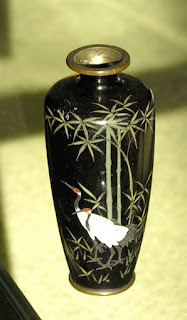
I well remember the day about 1947 that my Father brought home a framed picture of dogs playing poker, given to him by a dental supply company. An avid poker player himself, he was captured by the art and probably would have hanged it in a hallway had he not been backed down by my Mother. Little did any of us realize then what a cultural icon the picture and others like it would become in America. Nor at that time did we recognize its pedigree.
“Dogs Playing Poker” refers collectively to a series of oil paintings
 by Cassius Marcellus Coolidge, shown here. He was born in 1844 in Antwerp, New York to abolitionist Quaker farmers. Known to friends and family as "Cash,” Coolidge certainly knew how to turn his talent into cash. Although he had no formal training as an artist, his natural aptitude for drawing led him to create cartoons for his local newspaper when still in his early twenties. He gained national attention when he “invented” Comic Foregrounds, life-size painted cutouts into which one's head was placed and photographed, presumably resulting in hilarious effects.
by Cassius Marcellus Coolidge, shown here. He was born in 1844 in Antwerp, New York to abolitionist Quaker farmers. Known to friends and family as "Cash,” Coolidge certainly knew how to turn his talent into cash. Although he had no formal training as an artist, his natural aptitude for drawing led him to create cartoons for his local newspaper when still in his early twenties. He gained national attention when he “invented” Comic Foregrounds, life-size painted cutouts into which one's head was placed and photographed, presumably resulting in hilarious effects. When Coolidge was in his mid-50s, his creative imagination brought him to the attention of Brown & Bigelow, a St. Paul, Minnesota, advertising firm that wanted something new and different in an ad campaign for cigars. He obliged by painting a total of 16 pictures featuring anthropomorphized canines, of which nine showed dogs seated around a card table. The first three shown here are Coolidge’s work.
When Coolidge was in his mid-50s, his creative imagination brought him to the attention of Brown & Bigelow, a St. Paul, Minnesota, advertising firm that wanted something new and different in an ad campaign for cigars. He obliged by painting a total of 16 pictures featuring anthropomorphized canines, of which nine showed dogs seated around a card table. The first three shown here are Coolidge’s work. Like the Elvis or the Last Supper on velvet, Dogs Playing Poker have become derisively well-known in the United States as examples of low brow taste in home decoration. One critic has described Dogs Playing Poker as "indelibly burned into the American collective-schlock subconscious" because the images are so frequently seen.
Like the Elvis or the Last Supper on velvet, Dogs Playing Poker have become derisively well-known in the United States as examples of low brow taste in home decoration. One critic has described Dogs Playing Poker as "indelibly burned into the American collective-schlock subconscious" because the images are so frequently seen.In the current Disney/Pixar movie “Up,” a brief scene occurs of card-playing dogs. Coolidge’s creations also have had regular contemporary attention on TV programs like “Cheers,” and “The Simpsons.” In one recent episode of “Family Guy,” for example, the town mayor is discovered in the basement of the schoolhouse playing cards with dogs. The references go on and on.
The number of knockoffs of the paintings is also impressive. Shown here last are two contemporary artists’ variations on the Dogs Playing Poker theme. Note that these figures appear more like humans with appended canine heads than actual dogs.
The question remains of why Dogs Playing Poker has remained so popular an American icon for more than a century. My thought is that the incongruity of so animated an creature as a dog keeping a “poker face” like the best Texas Hold’em crowd just plain tickles the funny bones of generation-after-generation of Americans whose taste for wacky comedy never seems to flag.

Coolidge died in 1934 but not before seeing his creations embedded in American popular culture. If, improbably, he had lived to February 2005, he also would have seen two of his original Dogs Playing Poker paintings selling at auction for a whopping $590,400. It proves once again that in this country schlock sometimes can pay off big time.












